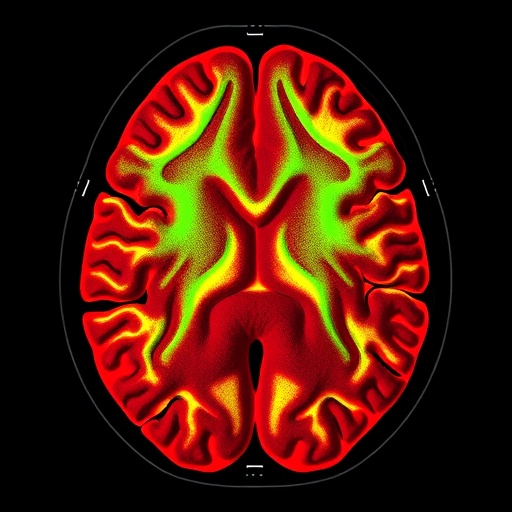In a groundbreaking study, researchers have employed advanced magnetic resonance imaging (MRI) techniques to elucidate the complex interplay between body compartments, metabolic traits, and immune phenotypes. This remarkable investigation, led by an expert team including Zhang, Li, and Zhang, represents a significant leap forward in understanding the underlying mechanisms that govern metabolic processes through the lens of genetics and immune responses.
The study is framed within the wider context of metabolic research, where the impact of body composition on health outcomes has garnered increasing attention. Traditional methods have often relied on standard imaging techniques or invasive measures, but this novel approach offers a non-invasive, comprehensive perspective on how body compartments—muscle, fat, and other tissues—interact with metabolic and immune responses. This integration is essential for constructing a holistic understanding of human health and disease.
At the heart of this investigation is the concept of Mendelian randomization, a powerful statistical method that utilizes genetic variants as instrumental variables to infer causal relationships. By taking advantage of natural genetic variation, researchers can minimize bias and confounding factors that often plague observational studies. This method stands out as particularly effective in establishing a causal link between body compartmentalization and various metabolic traits, presenting a clearer picture of how genetics and physiology contribute to individual health outcomes.
Using state-of-the-art MRI technology, the study meticulously quantified different body compartments. This detailed analysis not only allowed for precise measurements of muscle and fat distribution but also enabled the researchers to explore how these compartments affect metabolic functions. The results reveal intricate relationships where not only the amount of fat or muscle plays a crucial role but also their specific distribution across the body impacts metabolic health.
Immune phenotyping adds another layer of complexity to the research, linking the immune system’s responses to metabolic traits. The findings suggest that variations in body compartment distributions may correspond to distinct immune profiles, which could have profound implications for diseases characterized by metabolic dysfunction, such as diabetes and obesity. This linkage between metabolism and immunity opens avenues for targeted therapies that consider individual body composition and immune status.
The implications of these findings extend beyond academic interest; they offer practical applications in clinical settings. By understanding the causal relationships delineated in this study, healthcare providers can better tailor interventions based on an individual’s genetic makeup and body composition. For instance, personalized nutrition and exercise regimens could be developed, enhancing their efficacy by aligning with patients’ innate biological variations.
Moreover, this investigation also holds potential for broader public health initiatives. With rising obesity rates and associated metabolic disorders globally, strategies that incorporate findings from such research could inform community health programs aimed at reducing risks and improving population-level health outcomes. The evidence-based approach established through this study makes it a critical resource for policymakers and health education advocates.
As researchers dig deeper into the data and possible implications of this investigation, it stimulates further inquiries into how different lifestyle factors—such as diet and physical activity—intersect with genetic predispositions and body composition. Understanding these relationships is paramount, as lifestyle modifications have shown promise in ameliorating adverse metabolic and immune responses.
Furthermore, this study lays the groundwork for future research exploring the broader implications of body composition in various populations, including those with different ethnic backgrounds. Such investigations would be invaluable, as genetic and environmental factors vary significantly across demographics, influencing both health and disease risk. Expanding this research could ultimately lead to new insights into personalized medicine and the role of genetics in shaping health.
The incorporation of advanced imaging technology such as MRI illustrates not only the potential for enhanced data collection but also the importance of multidisciplinary approaches in modern health research. By fusing together disciplines such as genetics, immunology, and radiology, researchers can create a more comprehensive picture of human health, which may transform how we approach disease prevention and treatment.
In summary, the study elucidates the complex interactions between body compartmentalization, metabolic traits, and immune system responses, using sophisticated MRI techniques combined with Mendelian randomization. As the findings circulate through the scientific community, they spark excitement about the new paths this research opens. The potential to inform personalized health strategies and improve metabolic health outcomes resonates with scientists, clinicians, and public health officials alike, promising to usher in a new era of precision medicine.
The study offers a refreshing perspective, challenging existing paradigms that have often viewed metabolism and immunity as separate domains. By weaving these intricate threads together, it sets the stage for a more cohesive understanding of health—one that recognizes the importance of individual body composition and immune profiles. Ultimately, this research not only adds to the scientific body of knowledge but also inspires future inquiries that could reshape how we think about and approach metabolic health.
As findings from this investigation reach broader audiences, the discussions surrounding metabolic health, genetic predispositions, and personalized interventions are likely to intensify. It encourages critical reflection on the healthcare industry’s approach to treating metabolic disorders, emphasizing the need for a comprehensive strategy that accounts for an individual’s unique genetic and biological context.
This meticulous work has the potential not only for academic recognition but also for meaningful societal impact, paving the way for healthier communities equipped to combat metabolic diseases with informed strategies. As researchers continue to refine their methodologies and deepen their analyses, it is clear that the nexus of body composition, metabolism, and immunity will remain a vibrant and crucial area of exploration in health sciences.
In conclusion, the innovative research led by Zhang and colleagues epitomizes the exciting advancements in translational medicine, demonstrating how cutting-edge technologies can be harnessed to address complex biological questions. The synergy between imaging and genetic analysis fosters a deeper appreciation for the nuances of human health, compelling us to rethink traditional frameworks and embrace a more integrated approach to understanding and improving metabolic health.
Subject of Research: The interplay between body compartment effects, metabolic traits, and immune phenotypes through MRI and Mendelian randomization.
Article Title: Magnetic resonance imaging quantifies causal body compartment effects on metabolic traits via immune phenotypes—a Mendelian randomisation study.
Article References: Zhang, D., Li, Lp., Zhang, Yh. et al. Magnetic resonance imaging quantifies causal body compartment effects on metabolic traits via immune phenotypes—a Mendelian randomisation study. J Transl Med 23, 1158 (2025). https://doi.org/10.1186/s12967-025-07241-4
Image Credits: AI Generated
DOI:
Keywords: Metabolic health, body composition, immune phenotypes, Mendelian randomization, magnetic resonance imaging.
Tags: advanced imaging in health researchbody composition and health outcomesgenetic variants and causal relationshipsholistic understanding of human healthimmune phenotypes and metabolisminterplay between body compartments and metabolismMendelian randomization in metabolic studiesmetabolic traits and immune responsesMRI techniques for metabolic researchmuscle fat tissue interactionsnon-invasive imaging methods in medicinestatistical methods in biomedical research





